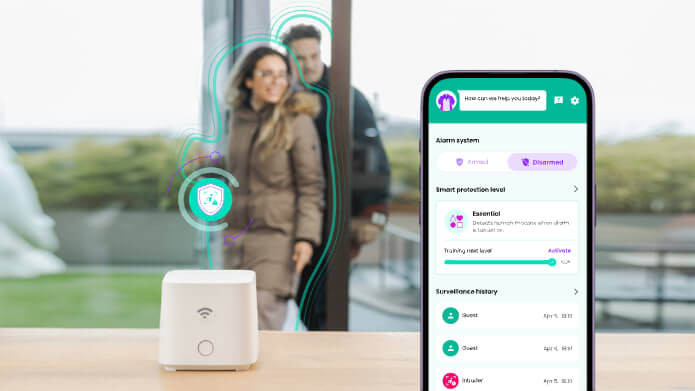Gamgee Uses Your Home's Wi-Fi as a Burglar Detector
Insights | 18-07-2024 | By Robin Mitchell

Gamgee, a company specialsing in innovative home security solutions, has introduced a unique concept of utilising Wi-Fi signals to detect intruders within households. By analysing disruptions in Wi-Fi signals caused by human movements, Gamgee aims to create a distinct 'body print' for each individual, differentiating between humans, pets, and objects. However, the effectiveness and reliability of this technology remain uncertain.
What challenges do typical burglar alarms face with regard to reliability and security, how advanced is the AI model in distinguishing between residents and intruders when searching for Wi-Fi disturbances, and what potential risks are associated with false detections by this Wi-Fi-based security system?
Key Things to Know:
- Gamgee's innovative home security solution uses Wi-Fi signals to detect intruders by analysing disruptions caused by human movements, creating a distinct 'body print' for each individual.
- This technology aims to simplify the setup of security systems by leveraging existing Wi-Fi infrastructure, reducing installation costs and complexity.
- While promising, the early stages of this AI-driven technology raise concerns about reliability and accuracy, particularly in distinguishing between normal activities and potential threats.
- To address privacy concerns, all motion data is securely encrypted and stored locally on the user's router, with full control provided through a dedicated mobile app.
The Dangers of Outdated Alarm Technology
The traditional method of installing burglar alarms has been reliant on ageing technologies, resulting in the systems of today struggling with several key issues that impact their reliability and effectiveness.
The high false alarm rate caused by pets, weather, and system malfunctions, for example, not only leads to unnecessary panic but can incur costly fines from authorities, undermining the very purpose of installing such alarms. Furthermore, the limited detection capabilities of basic sensors fail to provide comprehensive information about intrusions, such as the number of intruders, which can make it difficult for those alerted by the system to determine appropriate action.
The installation and maintenance requirements of traditional alarms also introduce significant barriers to entry, as they necessitate costly and inconvenient professional interventions, including initial setup and ongoing monitoring. Such obstacles often deter many homeowners from investing in the necessary security measures to safeguard their properties, thus eroding the reliability of such systems. Budget constraints and a lack of understanding of modern electronic systems can also cause both residents and business owners to invest in low-quality equipment whose reliability may be lacking (as well as having poor security features).
Additionally, the dependence of these alarms on physical infrastructure, such as wiring and connections, exposes them to tampering and potential failure, particularly during power outages. This vulnerability compromises the security and functionality of the alarm, undermining its ability to protect residential properties effectively.
Despite the numerous advances in technology, the ability to use this technology to defend homes and businesses continues to struggle, begging many to wonder how next generation technologies will address these challenges.
Integrating Smart Home Technologies and Overcoming Uncertainties in Protecting Living Spaces
Recognising the challenges faced by modern security systems, Gamgee has developed what it considers to be the most advanced security systems to date. The new solution utilises a combination of AI and Wi-Fi signals to detect intruders, which not only reduces the complexity of setting up security systems but could very well be applicable to all modern spaces. By analysing disruptions in Wi-Fi caused by human movements and distinguishing between humans, pets, and objects, this technology could significantly enhance the way we secure our living spaces.

One of the innovative features of Gamgee's system is its ability to utilise existing Wi-Fi infrastructure to create a virtual security network. This not only simplifies installation but also integrates seamlessly with everyday home environments. By transforming common household Wi-Fi into a vigilant monitoring system, Gamgee leverages ubiquitous technology to provide enhanced security without the need for additional hardware investments.
However, with every new advancement comes uncertainty, and the reliability and effectiveness of Gamgee's Wi-Fi detection technology raise a number of concerns. To start, the system's reliance on AI to recognise and learn individual movement patterns brings accuracy into question when detecting potential threats. For example, the differentiation between normal activities and potential dangers may prove to be a challenge, leading to false alarms or misidentifications.
Addressing Reliability and Accuracy Concerns
To mitigate these issues, continuous updates and machine learning improvements are critical. Gamgee’s system is designed to evolve over time, learning from each interaction and improving its ability to correctly identify and respond to various types of movements. This adaptive learning process is essential for reducing false alarms and increasing the system's overall accuracy, making it more reliable for long-term use.
Furthermore, the early stages of this technology's development raise concerns about its reliability and effectiveness, leading to a cautious approach by the security industry. As such, it is recommended that this technology be used in conjunction with traditional security measures rather than as a standalone solution.
Combining Traditional and Modern Security Measures
Another consideration is data privacy and security. Gamgee ensures that all motion data is securely encrypted and stored locally on the user's router, providing full control over personal information. This approach prevents data from being accessed by external entities, addressing privacy concerns associated with modern smart home technologies. Users can manage and review their data through a dedicated mobile app, ensuring transparency and peace of mind.
As the debate surrounding Gamgee's Wi-Fi detection technology continues, the importance of staying informed and being aware of the uncertainties associated with new technologies becomes evident. The success of the technology's IndieGogo campaign serves as a benchmark, with potential users keeping in mind the limitations and uncertainties that come with the early stages of technology development.
Despite these uncertainties, the potential benefits of Gamgee's Wi-Fi detection technology are significant. By combining AI with Wi-Fi signal analysis, this system represents a forward-thinking approach to home security. As the technology matures, it is likely to become a staple in modern homes, offering a high level of convenience and protection. The ongoing development and community feedback will be crucial in refining the system, ensuring it meets the high standards required for effective home security solutions.
Smart Homes and the Rise of Wi-Fi-Based Security Systems: Challenges and Future Directions
The integration of Wi-Fi-based security systems, such as the Gamgee system, into smart homes represents a significant advancement in the field of security monitoring. By detecting movements and changes within a home and differentiating between humans, pets, and objects, this technology provides a personalised 'body print' for enhanced security.
However, this system's reliance on AI to interpret Wi-Fi disruptions raises questions about false detections and misidentifications, highlighting the importance of addressing these challenges for the successful implementation of Wi-Fi-based security systems in smart homes. As such, the integration of Wi-Fi-based security systems into smart homes requires a comprehensive approach to address the challenges emerging from AI-powered technologies.
Future developments in this field should focus on improving the accuracy and reliability of AI algorithms to minimise false detections and ensure system reliability. Robust validation processes must be implemented to distinguish between various entities and differentiate between authorised and unauthorised activities. The use of machine learning techniques that adapt to the user's behavior can enhance the system's performance and accuracy over time, leading to more effective security monitoring.
However, Wi-Fi-based security systems like Gamgee should not be relied upon solely at this stage. While these technologies hold promise in the future, the emerging nature of this field means that such systems may not provide comprehensive protection. Therefore, it is crucial to continue using traditional security measures alongside Wi-Fi-based systems to ensure the best results. A multi-layered approach that combines human oversight with technology-enabled monitoring can lead to enhanced safety and security within smart homes.
As Wi-Fi-based security systems like Gamgee continue to evolve, it is essential to address the challenges associated with AI-powered technologies. By improving the accuracy and reliability of AI algorithms, enhancing system validation, and promoting a comprehensive approach to security monitoring, the integration of these systems into smart homes can lead to more effective and reliable protection.

